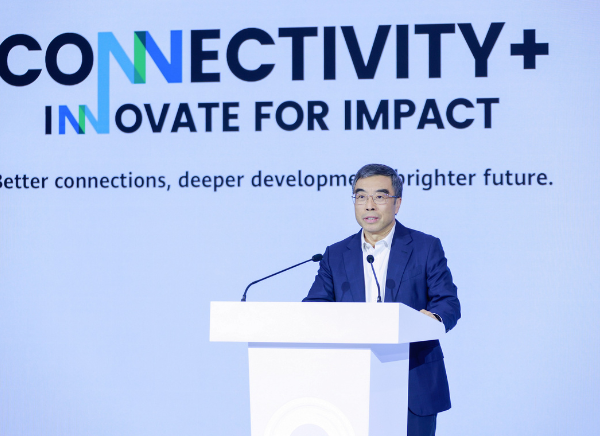
During the 2022 edition of Huawei’s Sustainability Forum, the technology provider signed a global commitment to join the International Telecommunication Union’s (ITU) Partner2Connect (P2C) digital alliance, aiming to bring connectivity to about 120 million people in remote areas in more than 80 countries by 2025.
In his keynote address, Dr. Liang Hua, Chairman of Huawei’s Board of Directors, stressed that access to a stable network was a basic requirement and right in the digital age. For many who remain unconnected, access to reliable connectivity would mark the first step towards transforming their lives.
“Connectivity will be more than just a tool for convenient communications,” he said. “Together with digital technologies like cloud and AI, connectivity will help bring everyone into the digital world and provide them with access to more information and skills, better services, and wider business opportunities. This will, in turn, drive further social and economic development.”
ITU is a neutral platform by the United Nations (UN) that coordinates the development of the Partner2Connect (P2C) Focus Areas Action Framework. Aiming to provide everyone with meaningful connectivity, P2C is built on the principles of inclusion, partnership, and SDG-focused digital development. Partner2Connect recognizes that progress can be achieved through multi-stakeholder collaboration and that the direct leadership of governments, policymakers, and the regulatory community is essential to achieve meaningful and universal connectivity.
In addition to Huawei’s pledge to bring connectivity to around 120 million people, it also supports inclusive development and is working towards driving broader digital inclusion through its TECH4ALL program. By the end of 2021, the TECH4ALL program had helped more than 110,000 people, including teachers and students from over 400 schools and unemployed young people, learn new digital skills and improve their scientific and technological literacy. In addition, each month, the accessibility functions on Huawei devices help 4.4 million visually impaired users and over 800,000 hearing impaired users use digital technology more seamlessly.
The company’s 2022 sustainability forum, “Connectivity+: Innovate for Impact,” also examined how ICT innovation could unleash the business and social value of connectivity and drive sustainability in the digital economy era. The forum welcomed decision makers, including speakers from the ITU and United Nations, telecom ministers, and regulators in Cambodia, Nigeria, Bangladesh, and Pakistan. In addition, business leaders, partners, experts, and customers from China, South Africa, Belgium, and Germany highlighted the importance of connectivity.
“It is clear connectivity alone is not enough. It must be affordable, the content must be relevant and in the local language, and users must have the skills to make the best use of it,” said ITU Deputy Secretary-General Malcolm Johnson. “Thank you to Huawei for supporting the Partner2Connect (P2C) Digital Coalition and their announced P2C pledges in the key areas of rural connectivity and digital skills.”
Rural areas have a huge demand for mobile communications. Huawei is committed to providing leading coverage solutions for rural areas; Huawei RuralStar and RuralLink fulfill this mission, helping operators bring mobile connectivity to rural areas and expand the benefits of digital connectivity to all.
RuralStar and RuralLink solutions bring together the full-technology innovation potential of Huawei equipment, sites, energy, transmission, and antennas to address the difficulties traditional site deployments face, such as high costs, restricted transportation, lack of power, and maintenance challenges.
Huawei launched the RuralLink solution through site-level innovations. This solution enables green sites, site simplification, and seamless evolution, enabling operators to build mobile networks that allow for positive business cycles in rural areas while connecting those who are still unconnected. Huawei’s RuralLink solution uses unique, innovative technologies to solve communication difficulties.
By leveraging its investments and focus on innovation, Huawei has continuously upgraded the RuralStar and RuralLink solutions to extend quality coverage to remote areas, enabling more people, community hospitals, schools, local governments, and small- and medium-sized enterprises to enjoy the same high-speed broadband connectivity experiences as those in cities. The RuralStar series solutions have provided connections for more than 60 million people in remote areas in more than 70 countries.
“Bringing stable connectivity to all is still a challenge. Many people around the world remain unconnected. So, connecting them is the first step. This will give them greater access to knowledge, digital skills training, and opportunities. According to the GSMA’s Mobile Economy Report 2022, only 6% of the world’s population lives in areas without mobile network coverage. But a huge usage gap remains, as many people who have coverage still don’t use the Internet. In 2021, the usage gap was 3.2 billion people or 41% of the world’s population. So, there is still a long way to go before everyone has easy access to quality Internet services,” added Dr. Liang.
As ICT infrastructure continues to evolve, innovative technologies like cloud and AI allow those in rural and remote areas to enjoy the convenience of a digital world. Huawei Cloud has proposed the Everything as a Service strategy and made Huawei’s more than 30 years of technical expertise and digital transformation experience available through cloud services. This means that access to Huawei’s digital infrastructure capabilities on the cloud is now just as easy, affordable, and sustainable as water and electricity.
Huawei is committed to inclusive development. Through its ongoing technological innovation, Huawei is contributing to a higher level of digitalization in remote regions, enabling everyone to enjoy the convenience of a digital life and promoting the balanced development of the global digital economy.